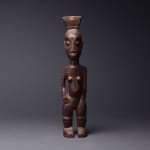Mangbetu Female Ancestral Sculpture, 20th Century CE
Wood
96.8 x 19.3 cm
38 1/8 x 7 5/8 in
38 1/8 x 7 5/8 in
PF.5913 (LSO)
Further images
This fine wooden carving of a standing woman was made by artists of the Mangbetu tribe, in what was once Zaire. It is made in the traditional style, and in...
This fine wooden carving of a standing woman was made by artists of the Mangbetu tribe, in what was once Zaire. It is made in the traditional style, and in the usual light-coloured wood. The figure is of complex construction with sectorial limbs, an angular torso, a long neck and a large head with an elaborate coiffure. The surface of the piece is decorated with a tracery of fine lines. The breasts are small and domed, the face serene and placid. The left hand rests on the left buttock, while the right hand rests on the right hip. The hair is unusual in not being conical; it instead describes a tall fan shape with an elongated queue down the back. The wood is polished with use patination.
The Mangbetu moved to the Congo region from Sudan in the 1700s, and live in societies that revolve around a court system. They are particularly renowned for their professional musicians, and also for their extravagant dancing and ceremonial pageantry. Their artworks were produced for the royal court families, and ranged from architecture to objects of religious/spiritual significance and secular items decorated with pleasing motifs and designs.
Mangbetu art is perhaps most recognizable for the inverted-cone coiffures of the (usually female) figures that tend to adorn it. This is seen in the rare wooden figures, as well as in ceramics. The coiffure – exaggerated by cranial deformation during infancy – was worn by women until the 1950s. Most of the pieces found their way to the royal courts. Kings were originally believed to be semi-divine, able to control natural resources using magical objects such as leopard parts. In the 1850s they were credited with possessing a force called nebeli, which was used to lure animals into traps and also to deceive colonial enemies. Their resistance to European rule had serious socioeconomic repercussions, but by the time that the European hold on the area had solidified, the Mangbetu were in the habit of trading and exchanging prestige goods – notably ornate ceramics – between chiefly courts and to colonials.
The role of these pieces is uncertain. The Mangbetu creator god is named Noro (also Kilima), but there is little sculptural abstraction in Mangbetu art that hints at an aim beyond the representational, or the secular decorative. They may also represent ancestors, which the kings usually command be revered. It is possible that the decorations on such pieces are designed to repel the negative effects of ‘Likundu’ – evil spirits – or witchery, which is a major concern in Mangbetu society.
This is a striking and appealing piece of Mangbetu art.
The Mangbetu moved to the Congo region from Sudan in the 1700s, and live in societies that revolve around a court system. They are particularly renowned for their professional musicians, and also for their extravagant dancing and ceremonial pageantry. Their artworks were produced for the royal court families, and ranged from architecture to objects of religious/spiritual significance and secular items decorated with pleasing motifs and designs.
Mangbetu art is perhaps most recognizable for the inverted-cone coiffures of the (usually female) figures that tend to adorn it. This is seen in the rare wooden figures, as well as in ceramics. The coiffure – exaggerated by cranial deformation during infancy – was worn by women until the 1950s. Most of the pieces found their way to the royal courts. Kings were originally believed to be semi-divine, able to control natural resources using magical objects such as leopard parts. In the 1850s they were credited with possessing a force called nebeli, which was used to lure animals into traps and also to deceive colonial enemies. Their resistance to European rule had serious socioeconomic repercussions, but by the time that the European hold on the area had solidified, the Mangbetu were in the habit of trading and exchanging prestige goods – notably ornate ceramics – between chiefly courts and to colonials.
The role of these pieces is uncertain. The Mangbetu creator god is named Noro (also Kilima), but there is little sculptural abstraction in Mangbetu art that hints at an aim beyond the representational, or the secular decorative. They may also represent ancestors, which the kings usually command be revered. It is possible that the decorations on such pieces are designed to repel the negative effects of ‘Likundu’ – evil spirits – or witchery, which is a major concern in Mangbetu society.
This is a striking and appealing piece of Mangbetu art.
1
of
12







